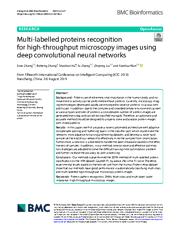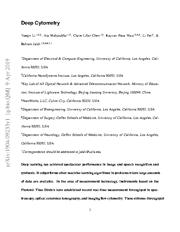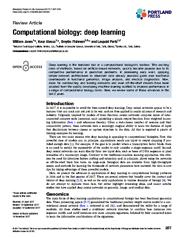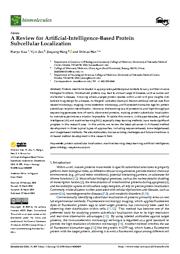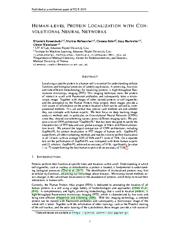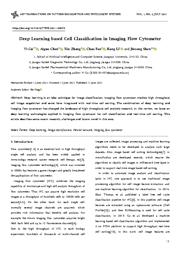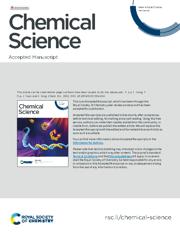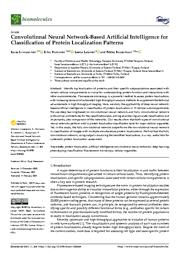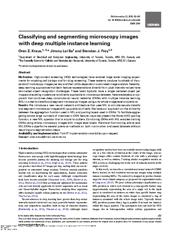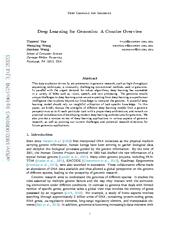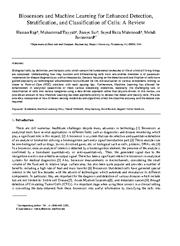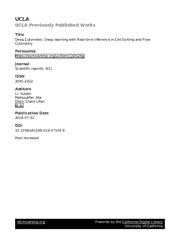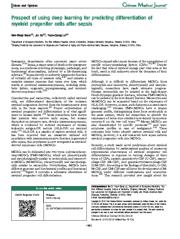A copy of this work was available on the public web and has been preserved in the Wayback Machine. The capture dates from 2021; you can also visit the original URL.
The file type is application/pdf.
Filters
Multi-labelled proteins recognition for high-throughput microscopy images using deep convolutional neural networks
2021
BMC Bioinformatics
high-throughput microscopy protein images. ...
Currently, microscopy imaging technologies developed rapidly are employed to observe proteins in various cells and tissues. ...
Acknowledgements The authors thank the Fa Zhang's Research Group of ICT, NCIC to support computation resources and thank the HPA to provide open-sourced data for experiments. ...
doi:10.1186/s12859-021-04196-3
pmid:34130623
pmcid:PMC8207617
fatcat:v6m6mivlffeplbuervxbejhkl4
Deep Cytometry
[article]
2019
arXiv
pre-print
Previously we had shown that high-throughput label-free cell classification with high accuracy can be achieved through a combination of time stretch microscopy, image processing and feature extraction, ...
Deep learning has achieved spectacular performance in image and speech recognition and synthesis. ...
Previously we had shown that high-throughput label-free cell classification with high accuracy can be achieved through a combination of time stretch microscopy, image processing and feature extraction, ...
arXiv:1904.09233v1
fatcat:uqdkmjkdd5fppohwxdtitnwije
Computational biology: deep learning
2017
Emerging Topics in Life Sciences
This exciting class of methods, based on artificial neural networks, quickly became popular due to its competitive performance in prediction problems. ...
Deep learning is the trendiest tool in a computational biologist's toolbox. ...
Acknowledgements We thank Oliver Stegle for the comments on the text. ...
doi:10.1042/etls20160025
pmid:33525807
pmcid:PMC7289034
fatcat:qnw2yndsp5aqlnxxshtaipzctu
A Review for Artificial-Intelligence-Based Protein Subcellular Localization
2024
Biomolecules
As the gold validation standard, the conventional wet lab uses fluorescent microscopy imaging, immunoelectron microscopy, and fluorescent biomarker tags for protein subcellular location identification. ...
However, the booming era of proteomics and high-throughput sequencing generates tons of newly discovered proteins, making protein subcellular localization by wet-lab experiments a mission impossible. ...
In addition to selecting and integrating key features during the image preprocessing steps, most of the deep neural networks consider processed image segmentation as inputs for multi-layer convolutional ...
doi:10.3390/biom14040409
pmid:38672426
pmcid:PMC11048326
fatcat:slimbidr5jaghlgws5qgl6uuce
Human-level Protein Localization with Convolutional Neural Networks
2019
International Conference on Learning Representations
A promising, low-cost, and time-efficient biotechnology for localizing proteins is high-throughput fluorescence microscopy imaging (HTI). ...
We here focus on deep learning image analysis methods and, in particular, on Convolutional Neural Networks (CNNs) since they showed overwhelming success across different imaging tasks. ...
A complementary and highly promising biotechnology that is used to localize proteins, is high-throughput fluorescence microscopy imaging (HTI), which is characterized by low costs and being time efficient ...
dblp:conf/iclr/RumetshoferHRHK19
fatcat:fka3fptfpfcerjpqxqduijud6u
Deep Learning based Cell Classification in Imaging Flow Cytometer
2021
ASP Transactions on Pattern Recognition and Intelligent Systems
Deep learning is an idea technique for image classification. Imaging flow cytometer enables high throughput cell image acquisition and some have integrated with real-time cell sorting. ...
The combination of deep learning and imaging flow cytometer has changed the landscape of high throughput cell analysis research. ...
Convolutional neural network extracts image features using convolutional kernels followed by a pooling layer. ...
doi:10.52810/tpris.2021.100050
fatcat:i2j4omuqxfbwhf5bhoqpqptr5q
Deep learning in single-molecule imaging and analysis recent advances and prospects
2022
Chemical Science
Single-molecule microscopy is advantageous to characterizing heterogeneous dynamics on the molecular level. ...
However, there are several challenges that currently hinder the wide application of single molecule imaging in bio-chemical studies,... ...
The most widely used deep neural network is the convolutional neural networks (CNNs). 89 CNNs are suitable for processing multidimensional data, such as image, audio signal, etc. ...
doi:10.1039/d2sc02443h
pmid:36349113
pmcid:PMC9600384
fatcat:prjtod43qzabjlpjyzohi7vabi
Convolutional Neural Network-Based Artificial Intelligence for Classification of Protein Localization Patterns
2021
Biomolecules
We use deep learning-based on convolutional neural network and fully convolutional network with similar architectures for the classification task, aiming at achieving accurate classification, but importantly ...
Fluorescence microscopy is a powerful method to assess protein localizations, with increasing demand of automated high throughput analysis methods to supplement the technical advancements in high throughput ...
Results We studied the efficiency of using convolutional neural networks for classification of protein localization patterns in a large scale. ...
doi:10.3390/biom11020264
pmid:33670112
pmcid:PMC7916854
fatcat:eilmepbzafdthkbyll664azq4m
Classifying and segmenting microscopy images with deep multiple instance learning
2016
Bioinformatics
Convolutional neural networks (CNN) have achieved state of the art performance on both classification and segmentation tasks. ...
Combining CNNs with MIL enables training CNNs using full resolution microscopy images with global labels. ...
Other groups have applied deep neural networks to microscopy for segmentation tasks (Ciresan et al., 2012; Ning et al., 2005) using ground truth pixel-level labels. ...
doi:10.1093/bioinformatics/btw252
pmid:27307644
pmcid:PMC4908336
fatcat:flyng5qnfjcvhb7fn2aiac2neq
Deep Learning for Genomics: A Concise Overview
[article]
2023
arXiv
pre-print
Advancements in genomic research such as high-throughput sequencing techniques have driven modern genomic studies into "big data" disciplines. ...
of developing modern deep learning architectures for genomics. ...
High-throughput microscopy images are a rich source of biological data remain to be better exploited. ...
arXiv:1802.00810v4
fatcat:lvq6icbdincircjt4x5t2cocru
Biosensors and Machine Learning for Enhanced Detection, Stratification, and Classification of Cells: A Review
[article]
2021
arXiv
pre-print
Sensors focusing on the detection and stratification of cells have gained popularity as technological advancements have allowed for the miniaturization of various components inching us closer to Point-of-Care ...
using a data-driven approach rather than physics-driven. ...
In another study, the authors used neural networks (NN) in inline holography microscopy for high-speed cell sorting. ...
arXiv:2101.01866v1
fatcat:rws7k3yp6ndmnlkqcvafmkgphi
Deep Cytometry: Deep learning with Real-time Inference in Cell Sorting and Flow Cytometry
2019
Scientific Reports
Previously we had shown that high-throughput label-free cell classification with high accuracy can be achieved through a combination of time-stretch microscopy, image processing and feature extraction, ...
Deep learning has achieved spectacular performance in image and speech recognition and synthesis. ...
Jalali would like to thank NVIDIA for the donation of the GPU system. ...
doi:10.1038/s41598-019-47193-6
pmid:31366998
pmcid:PMC6668572
fatcat:5seedcq6tnfpbczdtnvjkkbw6a
Prospect of using deep learning for predicting differentiation of myeloid progenitor cells after sepsis
2019
Chinese Medical Journal
Acknowledgements The authors thank Jiao-Jiao Yang, from the First Affiliated Hospital, School of Medicine, Zhejiang University, for providing assistance with language editing. ...
They collected images of moving single cells and cell divisions by long-term high-throughput time-lapse microscopy for the construction of cellular genealogies. ...
Then, a convolutional neural network was developed for automatically extracting shape-based features with a recurrent neural network architecture, modeling the dynamics of the cells, and predicting lineage ...
doi:10.1097/cm9.0000000000000349
pmid:31306223
pmcid:PMC6759120
fatcat:jcddjnei3vcv3lgwlslokalfj4
Defining host–pathogen interactions employing an artificial intelligence workflow
2019
eLife
For image-based infection biology, accurate unbiased quantification of host–pathogen interactions is essential, yet often performed manually or using limited enumeration employing simple image analysis ...
HRMAn thus presents the only intelligent solution operating at human capacity suitable for both single image and high content image analysis.Editorial note: This article has been through an editorial process ...
Acknowledgements We thank all members of the Frickel lab for productive discussion. We thank Mohamed-Ali Hakimi for providing transgenic Toxoplasma lines. ...
doi:10.7554/elife.40560
pmid:30744806
pmcid:PMC6372283
fatcat:26275c2njndcxeyxz5gtouui6y
Neural network control of focal position during time-lapse microscopy of cells
2018
Scientific Reports
Z-stacks of yeast cells growing in a microfluidic device were collected and used to train a convolutional neural network to classify images according to their z-position. ...
Here, we demonstrate a neural network approach for automatically maintaining focus during bright-field microscopy. ...
Acknowledgements The authors would like to thank the members of Roberts lab for discussions and for participating in the annotation tests. ...
doi:10.1038/s41598-018-25458-w
pmid:29743647
pmcid:PMC5943362
fatcat:4fgwmzuqnnggzpovvhabnbbgf4
« Previous
Showing results 1 — 15 out of 598 results

